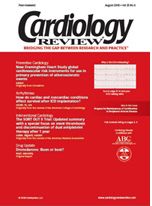Ezetimibe/simvastatin is another option for aggressive cholesterol goals
Lipid Disorders
Orlando—Ezetimibe/simvastatin (Vytorin) is superior to atorvastatin (Lipitor) in reducing levels of low-density lipoprotein (LDL) cholesterol across the dosing ranges. The two regimens are also comparable in their effect on C-reactive protein (CRP), reported Christie Ballantyne, MD, at the American College of Cardiology’s Annual Scientific Session 2005.
Achieving larger reductions in LDL cholesterol has gained considerable interest since last year when updated guidelines from the Adult Treatment Panel III of the National Cholesterol Education Program offered the option of an LDL cholesterol goal of less than 70 mg/dL for high-risk patients, said Dr. Ballantyne, director of the Center for Cardiovascular Disease Prevention, Methodist DeBakey Heart Center, Houston. The panel said that achieving a target of less than 70 mg/dL would probably require at least a 50% reduction in LDL cholesterol.
Furthermore, clinical studies with 80 mg/day of atorvastatin show a reduction in coronary heart disease (CHD) morbidity when compared with less aggressive lipid-lowering regimens, supporting a more aggressive LDL cholesterol goal.
“There are three ways to get a greater than 50% reduction in LDL cholesterol,” said Dr. Ballantyne. “One is atorvastatin, 80 mg. Another is rosuvastatin, 20 or 40 mg. The third is ezetimibe/simvastatin.”
The LDL cholesterol-reducing capacity of milligram-equivalent doses (10, 20, 40, and 80 mg) of ezetimibe/simvastatin and atorvastatin was compared in 1,902 patients with hypercholesterolemia in this randomized, double-blind, eight-arm study. Patients were treated for 6 weeks.
At the common starting doses of each medication—ezetimibe/simvastatin, 10/20 mg, and atorvastatin, 10 mg—ezetimibe/
simvastatin reduced LDL cholesterol by 51% compared with 36% for atorvastatin (P < .001).
In a subgroup of high-risk patients, defined as those with CHD or a CHD risk equivalent, 82% of those taking ezetimibe/simvastatin, 10/20 mg, achieved an LDL cholesterol goal of less than 100 mg/dL, compared with 47% of patients taking 10 mg of atorvastatin (P < .001).
In these high-risk patients, ezetimibe/
simvastatin, 10/40 mg, also produced larger LDL cholesterol reductions than atorvastatin, 40 mg (59% versus 49%;
P < .001).
In addition, 57% of the high-risk patients taking ezetimibe/simvastatin, 10/40 mg, achieved the more stringent LDL goal of less than 70 mg/dL, compared with 23% taking atorvastatin, 40 mg (P < .001). “It’s hard to get to less than 70 mg/dL,” said Dr. Ballantyne. “The point is if you’re trying to get to less than 70, you have to use highly effective therapy.”
Ezetimibe/simvastatin, 10/40 mg and 10/80 mg, was also associated with significantly greater increases (P < .001) in high-density lipoprotein (HDL) cholesterol (9.0% and 7.6%, respectively) compared with atorvastatin, 40 and 80 mg (increases of 3.8% and 1.5%, respectively). There was a trend toward greater increases in HDL cholesterol among patients taking ezetimibe/simvastatin, 10/10 and 10/20 mg, compared with atorvastatin, 10 and 20 mg.
A posthoc analysis of 1,832 patients in the study showed that both ezetimibe/
simvastatin and atorvastatin achieved a 25% reduction in CRP when averaged across all doses.
“The safety of both agents in this study was very good,” he said. There was a significantly greater incidence of consecutive elevations in liver enzymes of 3 times or more than the upper limit of normal in the pooled atorvastatin group (1.2%) compared with the pooled ezetimibe/simvastatin group (0.1%; P < .001). The incidence of muscle enzyme elevations was not significantly different between patients taking ezetimibe/simvastatin and those taking atorvastatin.
Clinical event trials with ezetimibe/
simvastatin are under way, but the agent appears promising in this regard given that simvastatin, 20 or 40 mg, has already been shown in the Heart Protection Study and the Scandinavian Simvastatin Survival Study to have a favorable effect on mortality and CHD morbidity.
